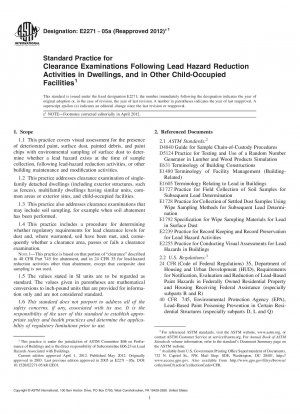ASTM E2271-05a(2012)e1
Standard Practice for Clearance Examinations Following Lead Hazard Reduction Activities in Dwellings, and in Other Child-Occupied Facilities
- Standard No.
- ASTM E2271-05a(2012)e1
- Release Date
- 2005
- Published By
- American Society for Testing and Materials (ASTM)
- Status
- Replace By
- ASTM E2271/E2271M-18
- Latest
- ASTM E2271/E2271M-22
- Scope
A clearance examination of abatement areas and other areas associated with other lead-hazard control activities, or building maintenance or modification activities in single-family detached dwellings, multifamily dwellings having similar units, common areas or exterior sites, and child-occupied facilities is performed to determine that the clearance area is adequately safe for reoccupancy.
It is the responsibility of the user of this standard to assure that all regulatory, contractual, and personnel requirements are met prior to conduct of a clearance examination. At a minimum, users of this standard shall be trained in its use and in safe practices for its conduct.
This practice is one of a set of standards developed for lead hazard management activities. The visual assessment procedures required in this standard are found in Practice E2255 and the record keeping requirements are found in Practice E2239.
Although this practice was primarily developed for dwellings and for other child-occupied facilities, this practice may be also applied to nonresidential buildings and related structures by agreement between the client and the individual conducting the clearance examination.
This practice may be used by owners and property managers, including owner-occupants, and others responsible for maintaining facilities. It may also be used by lead hazard management consultants, construction contractors, labor groups, real estate and financial professionals, insurance organizations, legislators, regulators, and legal professionals.
This standard does not address whether lead-hazard reduction activities or other building modification or maintenance work were done properly.
1.1 This practice covers visual assessment for the presence of deteriorated paint, surface dust, painted debris, and paint chips with environmental sampling of surface dust to determine whether a lead hazard exists at the time of sample collection, following lead-hazard reduction activities, or other building maintenance and modification activities.
1.2 This practice addresses clearance examination of single-family detached dwellings (including exterior structures, such as fences), multifamily dwellings having similar units, common areas or exterior sites, and child-occupied facilities.
1.3 This practice also addresses clearance examinations that may include soil sampling, for example when soil abatement has been performed.
1.4 This practice includes a procedure for determining whether regulatory requirements for lead clearance levels for dust and, where warranted, soil have been met, and, consequently whether a clearance area, passes or fails a clearance examination.
Note 18212;This practice is based on that portion of “clearance” described in 40 CFR Part 745 for abatement, and in 24 CFR 35 for lead-hazard reduction activities other than abatement, except that composite dust sampling is not used.
1.5 The values stated in SI units are to be regarded as standard. The values given in parentheses are mathematical conversions to inch-pound units that are provided for information only and are not considered standard.
1.6 This standard does not purport to address all of the safety concerns, if any, associated with its use. It is the responsibility of the user of this standard to establish appropriate safety and health practices and determine the applicability of regulatory limitations prior to use.
ASTM E2271-05a(2012)e1 Referenced Document
- ASTM D4840 Standard Guide for Sample Chain-of-Custody Procedures
- ASTM D5124 Standard Practice for Testing and Use of a Random Number Generator in Lumber and Wood Products Simulation
- ASTM E1480 Standard Terminology of Facility Management (Building-Related)
- ASTM E1605 Standard Terminology Relating to Lead in Buildings
- ASTM E1727 Standard Practice for Field Collection of Soil Samples for Lead Determination by Atomic Spectrometry Techniques
- ASTM E1728 Standard Practice for Field Collection of Settled Dust Samples Using Wipe Sampling Methods for Lead Determination by Atomic Spectrometry Techniques
- ASTM E1792 Standard Specification for Wipe Sampling Materials for Lead in Surface Dust
- ASTM E2239 Standard Practice for Record Keeping and Record Preservation for Lead Hazard Activities
- ASTM E2255 Standard Practice for Conducting Visual Assessments for Lead Hazards in Buildings
- ASTM E631 Standard Terminology of Building Constructions
ASTM E2271-05a(2012)e1 history
- 2022 ASTM E2271/E2271M-22 Standard Practice for Clearance Examinations Following Lead Hazard Reduction Activities in Multifamily Dwellings
- 2018 ASTM E2271/E2271M-18 Standard Practice for Clearance Examinations Following Lead Hazard Reduction Activities in Multifamily Dwellings
- 2005 ASTM E2271-05a(2012)e1 Standard Practice for Clearance Examinations Following Lead Hazard Reduction Activities in Dwellings, and in Other Child-Occupied Facilities
- 2005 ASTM E2271-05a Standard Practice for Clearance Examinations Following Lead Hazard Reduction Activities in Single-Family Dwellings and Child-Occupied Facilities
- 2005 ASTM E2271-05 Standard Practice for Clearance Examinations Following Lead Hazard Reduction Activities in Single-Family Dwellings and Child-Occupied Facilities
- 2004 ASTM E2271-04 Standard Practice for Clearance Examinations Following Lead Hazard Reduction Activities in Single-Family Dwellings and Child-Occupied Facilities
- 2003 ASTM E2271-03 Standard Practice for Clearance Examinations Following Lead Hazard Reduction Activities in Single-Family Dwellings and Child-Occupied Facilities
